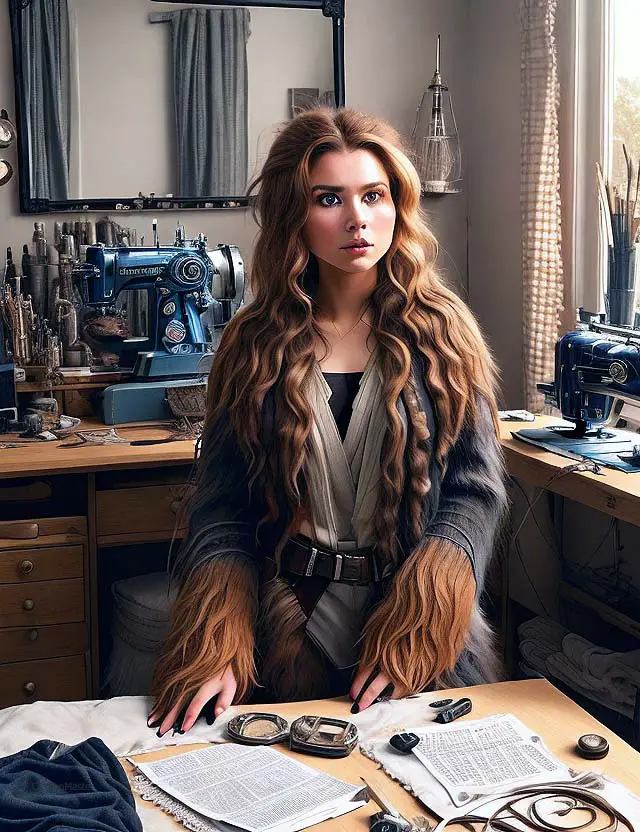If you’re a cosplay enthusiast, or just someone who enjoys dressing up in elaborate costumes, you know that the right materials can make all the difference. One material that has become increasingly popular in recent years is fake fur – a synthetic textile made to look and feel like animal fur. In this article, we’ll explore what fake fur is, why it’s such a great option for cosplay costumes, and how to work with it effectively.
Fake fur has several advantages when it comes to cosplay costuming. For starters, it’s cruelty-free – no animals are harmed in its production. We always recommend using fake fur instead of real fur. This goes for leather vs faux leather too .
This makes it an ethical choice for those who want to avoid using real animal products. Additionally, fake fur can be more affordable than real fur or other high-end fabrics commonly used in cosplay costumes.
Another benefit of using fake fur is its versatility – there are many different types of fake furs available on the market today, each with unique textures and colors that can be used to create a wide variety of looks. From long pile faux polar bear to short pile faux rabbit hair and even shaggy Mongolian lamb texture styles are available which creates fantastic looks.
Of course, working with fake fur does require some special techniques and tools due to its unique properties as a synthetic textile. But fear not!
With a little bit of practice and patience, anyone can learn how to handle this versatile material. In the following sections of this article, we’ll dive into specific tips on choosing the right type of fake fur for your project; preparing the material before use; cutting and sewing it effectively; styling it for realistic results; maintenance afterward- so that your costume looks amazing from every angle!

Choosing the Right Type of Fake Fur
The Different Types of Fake Fur Available
Fake fur is available in various textures and styles, each with its pros and cons. Long pile fake fur has longer hairs that are plush and soft, making it a great choice for creating a realistic-looking animal. Short pile fake fur has shorter hair fibers, giving it a sleeker appearance.
Curly fake fur features tightly curled fibers that resemble sheepskin or poodle hair. Another type of fake fur is the shaggy style, which has long shaggy strands.
This type of fur is perfect for creating wild animal costumes like lions or tigers. Additionally, there’s also the faux mink style that mimics the luxurious appearance of authentic mink fur.
Selecting the Best Type of Fake Fur for Your Specific Cosplay Project
When selecting the right type of fake fur for your cosplay project, consider your costume’s overall look and feel. For example, long pile fake fur works well for creating realistic-looking animals while short pile faux-fur is ideal for costumes with a sleeker design. If you’re working on a cosplay costume that requires curls or waves on certain areas such as tails or ears then curly-featured faux-fur might be ideal because it maintains its texture even when cut into small pieces.
Thickness is another factor to consider when selecting faux-fur types since some will have thicker fibers than others. A thick fibered material will be ideal for costumes where you need to create volume by adding bulk to specific areas such as shoulders, necks to give that “beastly” appearance while thinner options can achieve a more delicate look.
There are various types of fake furs available in different styles, textures, thicknesses and they all have their unique characteristics making them ideal for specific cosplay projects. It’s important to choose the right faux-fur type that will help you achieve the desired look and feel for your costume.
Preparing Your Fake Fur
Washing and Drying Fake Fur
Before you start working on your cosplay costume, it’s important to wash and dry your fake fur. This is because fake fur can be coated with chemicals that might irritate your skin or cause allergic reactions.
Additionally, washing the fur can help remove any dirt or debris that might have accumulated on it during the manufacturing process. To wash your fake fur, start by filling a large basin or sink with lukewarm water and a small amount of mild detergent.
Gently swirl the fur around in the water for a few minutes to let the detergent do its job. Try to avoid scrubbing or rubbing the fur too hard, as this could damage the fibers.
Once you’ve finished washing the fake fur, rinse it thoroughly under running water to remove any soap residue. Be sure to support the weight of the wet faux fur fabric so that it doesn’t become stretched out of shape.
After rinsing, use a towel to gently blot excess water from the fabric. Don’t wring out or twist your faux fur material as this may cause matting.

Removing Tangles and Knots
It’s not uncommon for tangles and knots to form in faux fur during washing either due to agitation in machine wash or due to rubbing together while washing by hand. These tangles can be annoying but they are relatively easy to deal with.
The best way is never combing your wet faux-fur; instead use fingers gently detangle while still damp. When removing tangles from fake fur be careful not stretch too hard on individual strands as it may pull them out of place causing bald spots on you costume piece.
In some cases synthetic hairs might fuse together forming clumps – especially when exposed heat sources like driers- In such cases, trimming them off carefully helps restore normalcy. Once the fur is untangled, lay it flat on a clean towel to air dry.
Avoid using a hair dryer, heating gun or any other source of heat to speed up the drying process, as this can damage the fibers and leave your fake fur looking frizzy. With these simple steps, your faux fur will be ready for use in your cosplay costume in no time!
Cutting and Sewing Fake Fur: Creating a Professional Finish to Your Cosplay Costume
Cutting and sewing fake fur can be a bit tricky, but with the right tools and some patience, you can create a perfect finish to your cosplay costume. Here are some tips for cutting and sewing fake fur.
Tools Needed for Cutting Fake Fur
The first step is to gather the proper tools. You will need sharp scissors or a rotary cutter, which will make cutting through the thick fibers of fake fur much easier. It’s essential that you use high-quality scissors because cheap ones tend to tear rather than cut through the fabric.
Another tool that might come in handy is a lint roller. Running it over the fabric before you cut can help remove any loose fibers that could get in the way while you work.
Tips for Cutting Fake Fur Without Damaging Fibers
When it comes to cutting fake fur, there are several techniques that can help prevent damage to the fibers. One of them is to use a chalk marker or tailor’s chalk to mark where you want to cut. This method will allow you to see where you’re going without accidentally marking up your fur.
Another technique is not to cut through all of the fibers at once but instead gently score them with your scissors or rotary cutter. Then follow up with another pass until all fibers have been completely severed.
Sewing Fake Fur Together by Hand or Machine
Sewing fake fur together can seem daunting, but it’s actually quite easy if you have some practice under your belt. The key is using long stitches because shorter ones tend not to hold as well due to the thickness of the fabric.
You can sew fake fur together either by hand or using a sewing machine; both techniques work well depending on what’s most comfortable for your style of sewing. If you’re using a machine, use a heavy-duty needle to prevent it from breaking when sewing through thick fabric.
Tips for Hiding Seams
One of the most important things when working with fake fur is hiding your seams. If you’re using a sewing machine, make sure to sew in the direction of the fur so that it hides the seam. If you’re sewing by hand, use a whip stitch and make sure that your thread color matches your fabric as closely as possible.
Another great tip is to trim away any excess fur on either side of the seam allowance before sewing them together. This will help ensure that there are no stray fibers sticking out from the finished product.
Styling Your Fake Fur
The Art of Brushing: One of the Most Essential Steps in Styling Fake Fur
Brushing is one of the most essential aspects of styling fake fur for cosplay costumes. It helps to create a more realistic look by giving the fur a natural sheen and texture.
The first step in brushing fake fur is to identify the direction of the pile – this is important because brushing against it can damage the fibers. Once you’ve determined which way it goes, use a soft-bristled brush or comb to gently stroke it in that direction.
If you’re working with long-pile fake fur, you may need to brush it multiple times from different directions to ensure that all areas are covered. Be patient and gentle when brushing – if you pull too hard, you risk damaging the fibers and creating bald spots.
Trimming Your Fake Fur: Cutting Corners (Literally!)
Trimming your fake fur can help give it a more polished appearance and make it look more like real animal hair. Start by identifying any areas where excess fur might be causing bulk or awkwardness, such as around seams or areas where pieces have been sewn together.
Use sharp scissors to carefully trim away any extra strands – remember, just like with regular haircuts, it’s better to start conservatively and trim more if necessary than to take off too much at once. When trimming your fake fur for cosplay purposes, keep in mind what kind of animal you’re trying to emulate.
Does your chosen animal have long ears or a fluffy tail? Try cutting small tufts of extra material and attaching them with thread or glue to achieve your desired effect.
Making Animal Features with Fake Fur: Ears, Tails and More!
One great use for fake fur in cosplay costumes is creating realistic-looking animal features like ears, tails, and paws. Creating a pair of furry ears can be as simple as cutting two identical triangles from your fake fur and sewing them to a headband or hair clips. Tails can be created in a similar way, and can be stuffed with batting or cotton to give them a more three-dimensional appearance.
For more complex animal features, such as paws or hooves, you may want to consider using foam for structure and shape. Cover the foam with fake fur using glue or stitching to achieve your desired look.
Tips for Perfecting Your Fake Fur Styling Techniques
– Always start with high-quality fake fur that is appropriate for your cosplay project – cheaper materials are often synthetic and prone to shedding. – Make sure to brush your fake fur gently and in the correct direction to avoid damaging it. – Practice trimming on small pieces before attempting larger projects.
– Use sharp scissors when trimming or cutting your fake fur. – Consider spraying hairspray on the finished product before wearing it out – this can help keep stray strands in place throughout the day.
Maintenance:
Once your cosplay costume is complete, you’ll want to take good care of it so that it lasts a long time. Fake fur can be delicate, so it’s important to follow some basic maintenance tips.
First, never put your fake fur costume in the washing machine or dryer! Hand-washing is always best.
Fill a sink or basin with cool water and add a gentle detergent. Swish the costume around gently before rinsing thoroughly with cool water.
Never wring out the fur – instead, press gently to remove excess water and then hang or lay flat to dry. If you notice any stains on your fake fur costume, don’t panic!
Apply some mild detergent directly to the stain and let it sit for a few minutes before blotting with a clean cloth. If the stain is particularly stubborn, you may need to visit a professional cleaner.
Conclusion:
Working with fake fur for cosplay can be both rewarding and challenging! With these tips in mind, you should be well-equipped to tackle your next furry project with confidence. Remember that practice makes perfect – don’t be afraid to experiment with different types of fake fur or techniques until you find what works best for you.
And most importantly – have fun! Cosplay is all about expressing your creativity and passion for your favorite characters and fandoms. This can be one of the more difficult materials to use for a project. If you’re looking for something more beginner friendly, we hav a guide to beginner friendly cosplay projects.
Whether you’re attending conventions or just showing off your work online, there’s nothing quite like the feeling of seeing people enjoy what you’ve created. So go forth and create something amazing – we can’t wait to see what you come up with!




